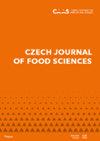Polyamines in plasma membrane function in melatonin-mediated tolerance of apricot fruit to chilling stress
IF 1
4区 农林科学
Q4 FOOD SCIENCE & TECHNOLOGY
引用次数: 1
Abstract
Polyamines are closely associated with environmental stresses and melatonin pretreatment enhances the resistance of fruit to chilling stress. However, a mechanism underlying melatonin-mediated chilling resistance remains to be answered. This research aimed to illuminate whether polyamines would be involved in melatonin-mediated chilling resistance. Therefore, in the experiment, the polyamines conjugated to the plasma membrane from the melatonin-pretreated apricot flesh cell were examined under chilling stress. Chilling resistance was judged by four parameters: fruit browning degree, plasma membrane permeability, malondialdehyde content and plasma membrane protein sulfhydryl level. Results showed melatonin pretreatment led to obvious rises in the levels of non-covalently conjugated spermine and spermidine, and covalently conjugated putrescine and spermidine in the plasma membrane. Methylglyoxyl-bis (guanylhydrazone) pretreatment could inhibit the melatonin-induced increases of non-covalently conjugated spermidine and spermine by inhibiting S-adenosylmethionine decarboxylase (SAMDC) activity and free spermidine and spermine contents in flesh, coupled with the decrease in chilling resistance. Similarly, phenanthroline pretreatment could inhibit the melatonin-induced increases in covalently conjugated putrescine and spermidine in the plasma membrane through inhibiting transglutaminase (TGase) activity and simultaneously could aggravate chilling damage. The results suggested melatonin pretreatment could enhance chilling resistance by increasing non-covalently conjugated spermidine and spermine, as well as covalently conjugated putrescine and spermidine in the plasma membrane of apricot fruit.质膜中的多胺在褪黑素介导的杏果实抗寒性中的作用
多胺与环境胁迫密切相关,褪黑素预处理可增强果实对低温胁迫的抗性。然而,褪黑激素介导的抗寒性的机制仍有待解答。本研究旨在阐明多胺是否参与褪黑激素介导的抗寒性。因此,本实验对褪黑激素预处理的杏果肉细胞在低温胁迫下的质膜偶联多胺进行了研究。通过果实褐变程度、质膜通透性、丙二醛含量和质膜蛋白巯基水平4个指标来判断其抗寒性。结果显示,褪黑素预处理导致质膜中非共价共轭精胺和亚精胺以及共价共轭腐胺和亚精胺水平明显升高。甲基乙醛-双胍(鸟酰腙)预处理可以通过抑制s -腺苷甲硫氨酸脱羧酶(SAMDC)活性和果肉游离亚精胺和精胺含量,抑制褪黑素诱导的非共价共轭亚精胺和精胺含量的增加,同时降低抗寒性。同样,菲罗啉预处理可以通过抑制转谷氨酰胺酶(TGase)活性来抑制褪黑素诱导的质膜共价共轭腐胺和亚精胺的增加,同时加重冷害。结果表明,褪黑素预处理可以通过增加杏果实质膜中非共价共轭亚精胺和精胺,以及共价共轭腐胺和亚精胺来增强杏果实的抗寒性。
本文章由计算机程序翻译,如有差异,请以英文原文为准。
求助全文
约1分钟内获得全文
求助全文
来源期刊

Czech Journal of Food Sciences
Food Science & Technology, Chemistry-食品科技
CiteScore
2.60
自引率
0.00%
发文量
48
审稿时长
7 months
期刊介绍:
Original research, critical review articles, and short communications dealing with food technology and processing (including food biochemistry, mikrobiology, analyse, engineering, nutrition and economy). Papers are published in English.
 求助内容:
求助内容: 应助结果提醒方式:
应助结果提醒方式:


